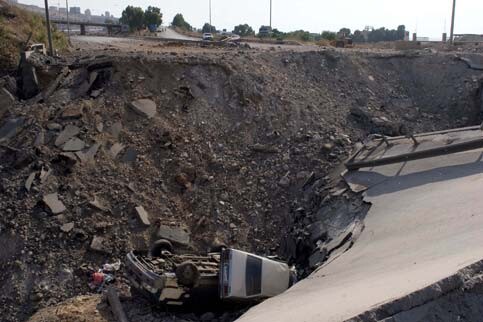Electronic Lebanon 16 August 2006

The coast road from Beirut to Khader, demolished by an Israeli air strike on the 13th of July. (MaanImages/ Raoul Kramer)
As soon as the UN resolution 1701 became effective on the morning of Monday 14th of August, partisan journalists embarked on propagandising the victory; politicians ran debates on performance and political outcomes of this war, military experts turned to assess the effectiveness and ineffectiveness of their weapons, and diplomats continued to debate the meaning of each word in the UN resolution. Lebanese civilians, however, were left to face the harsh reality of this destructive war.
Lebanese civilians especially those from South Beirut, South Lebanon and Bekaa walked back to their villages and cities to discover their houses either destroyed or damaged. Whole neighbourhoods in Beirut suburbs were scorched. Some of the quarters in the southern cities of Bint Jbeil, Nabatieh, and Tyre have witnessed mass destruction of unprecedented scale. Tens of villages in South Lebanon, as journalists and humanitarian workers have reported, have been wiped out.
There are no exact figures yet on the degree of destruction, and it will take some time until the relief and assessment teams reach villages and towns to count the damages. But early estimates show that the overall losses to housing and small business properties are likely to exceed the total for the country’s 15-year civil war (1975-1990). Lebanese government officials say that up to 200,000 Lebanese could be homeless. This means roughly that around 40.000 families will be roofless, a frightening figure in a small country of 3.6 million.
The magnitude of this housing crisis puts some serious matters on the Lebanese government’s table. With around 5.6 % of the population expected to be homeless, the issue should also receive some up-most attention from civil society organisations, International Governmental Organisations (IGOs) as well as the private sector.
It is wise from the beginning to acknowledge the weak role that the Lebanese state has so far played in the housing sector. Housing has so far been run by the market mechanisms with minimal government intervention. The Housing Foundation, a governmental agency, is the only government body that works in the housing sector albeit only through cooperating with private banks on devising loan mechanisms.
Not unwise as well to admit the unsuccessful past experiences in some of the post-conflict housing initiatives that the Lebanese government has previously employed. Programmes such as those aimed at rebuilding and/or compensating those with damaged or destroyed properties were not ideal. Initiatives were geographically and thematically fragmented as it was the case in the ‘Council of the South’, ‘Central Fund for Displaced’, and ‘Ministry of Displaced’. Poor monitoring and shady practices were often reported .
The available options for post-conflict housing reconstruction, I would argue are three:
Firstly, government direct intervention through existing bodies such as ‘Council of the South’ and the ‘Ministry of Displaced’ to construct houses and properties. Previous experience has shown, however, that this option is not ideal. Direct government intervention has often failed to deliver compared to the private sector and direct intervention is often crippled by the weak governmental agencies.
Secondly, the ‘privatisation’ option through offering financial assistance to those who lost their houses in order to reconstruct them. This was mostly practiced by the ‘Central Fund for the Displaced’ in Beirut and in some areas in Mount Lebanon. Though it was effective in paying for the illegal occupants to move out, it was not the best option with its lack of transparency. Stories of corrupt practices and channelling monies for political reasons were reported. Privatisation of reconstruction has also led, as past experiences have showed, to a building mess that took less consideration for urban master plans and the spatial fabric.
Thirdly, an ‘independent agency’ for the reconstruction of the July 2006 war destruction. This sounds to be the most sensible option at the moment. Such agency should be set-up to include a tripartite public - private - community partnership with a mandate to design new urban and rural master plans, to sub-contract reconstruction projects preferably through municipal authorities - especially of the totally destructed areas - and to offer financial assistance for individuals wishing to rebuild themselves. Giving this agency the authority to plan, fund and build will save funds and minimize the duplication that is often seen in post-conflict rehabilitation projects. It will also ensure the standards and quality of reconstruction according to a unified master plan. Municipalities and local communities should be the backbone of this initiative for their role as local authority and knowledge of needs at the local level. Private sector through banks and financial institutions could play a major role in speeding-up the construction process. They could provide funds to this agency at low rates that would match governmental and international funds.
Whatever options the Lebanese government adopt, it has to come out with exceptional policies and sound practices and to employ an exceptionally rapid response to this crisis. Foremost need is the formulation of the right governance structure that would framework the post-conflict reconstruction process. From the beginning the government should set-up a mechanism to ensure transparency and accountability. Information-sharing and openness to the public should be paramount. In each reconstruction step, it is vital to involve local authorities such as municipalities, community representatives and civil society organisations as well as the private sector. The activities of international organisations, whether in lending or in implementing, should be properly channelled through one central body to avoid duplication and poor practices.
Nasser Yassin is an Associate Fellow in the Hague-based Institute for Environmental Security and researcher in urban development. Email: nasser.yassin@gmail.com
Related Links
